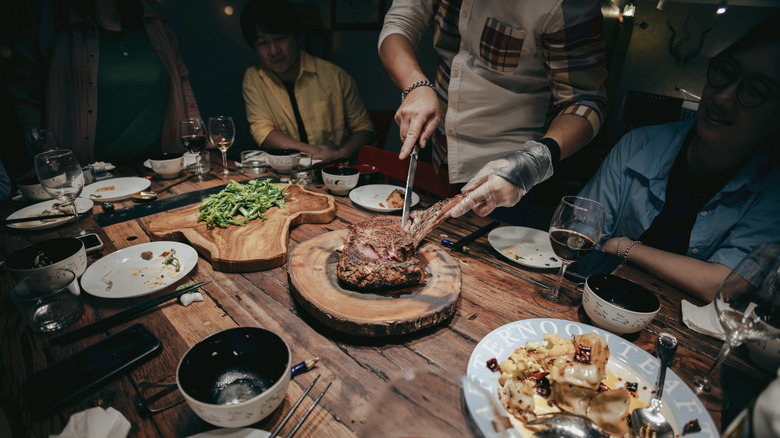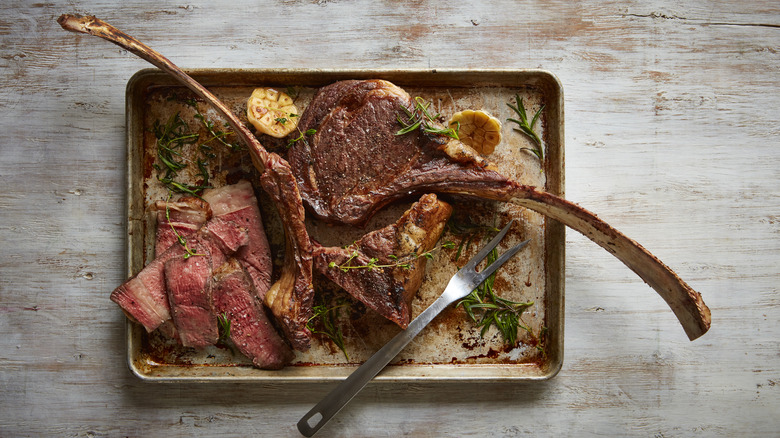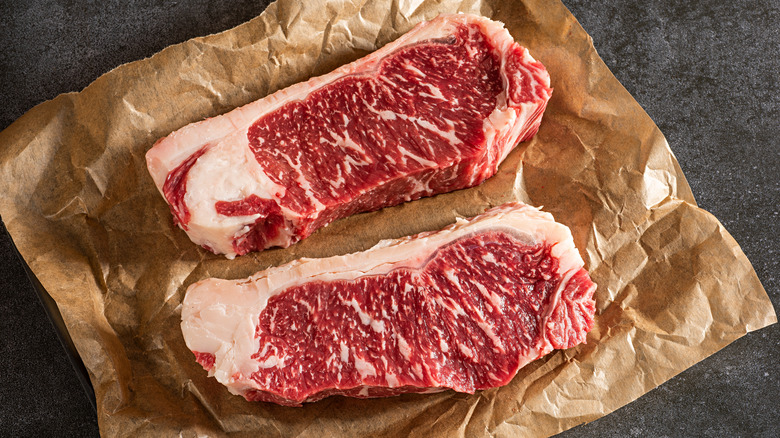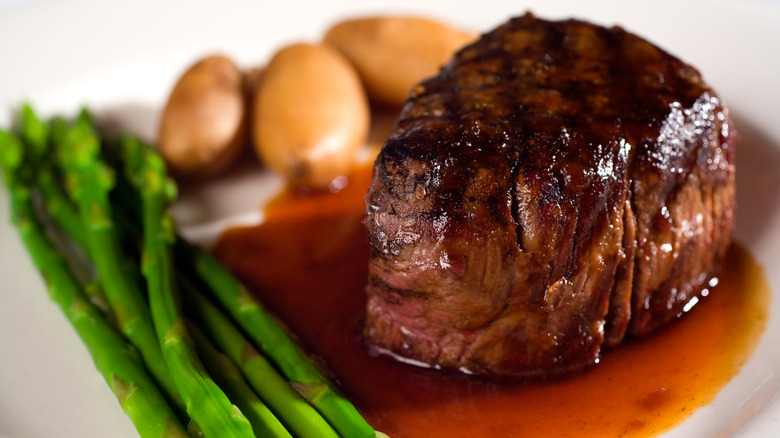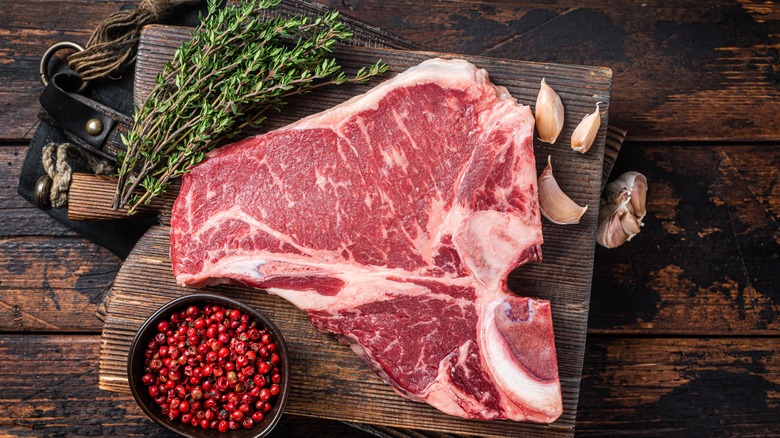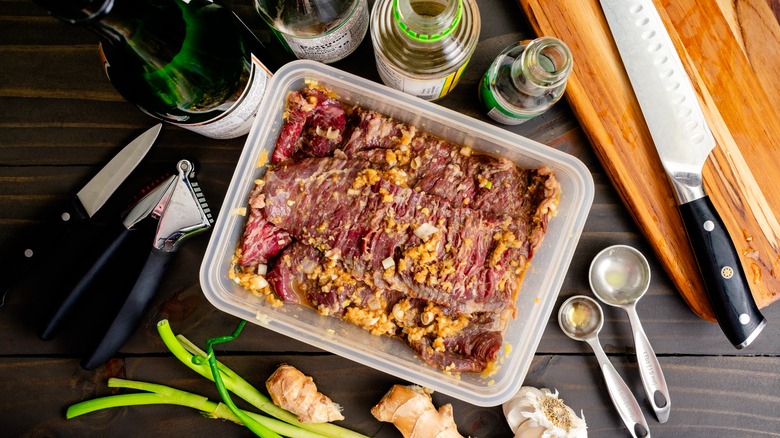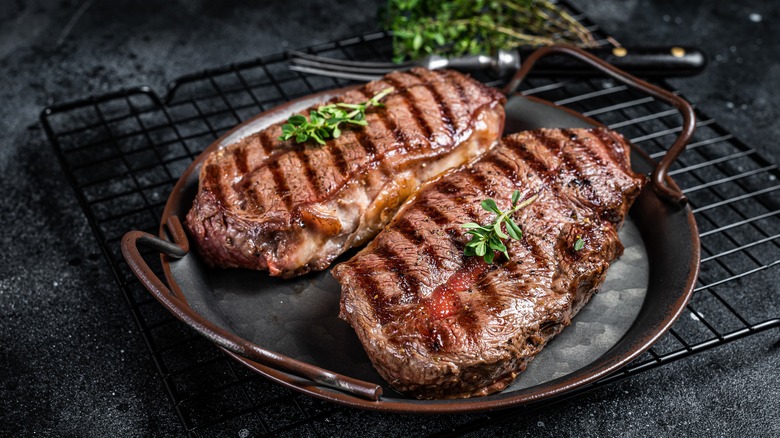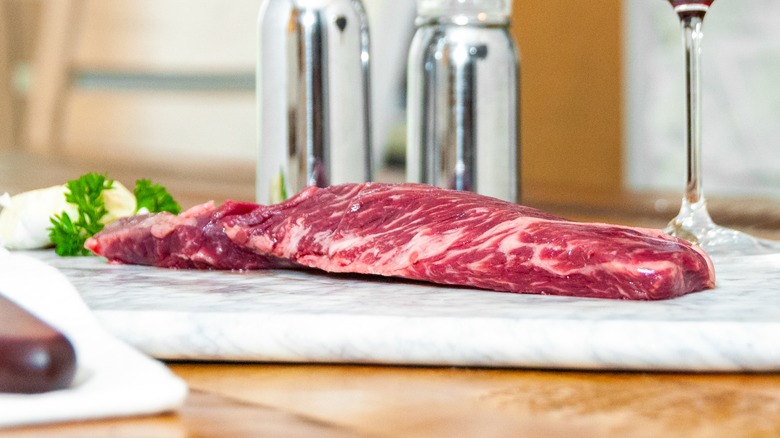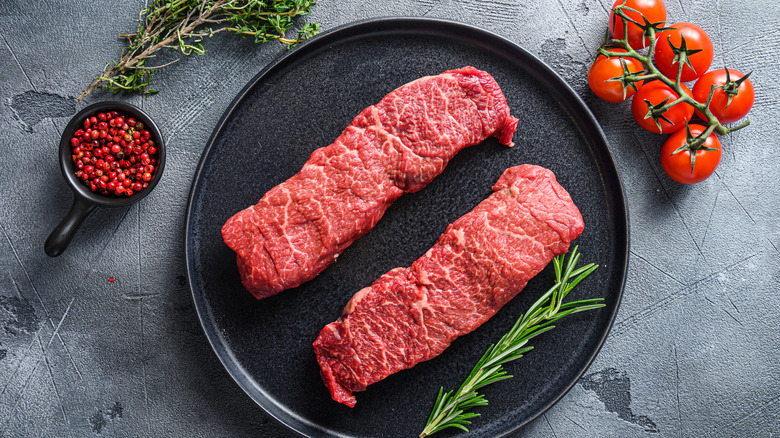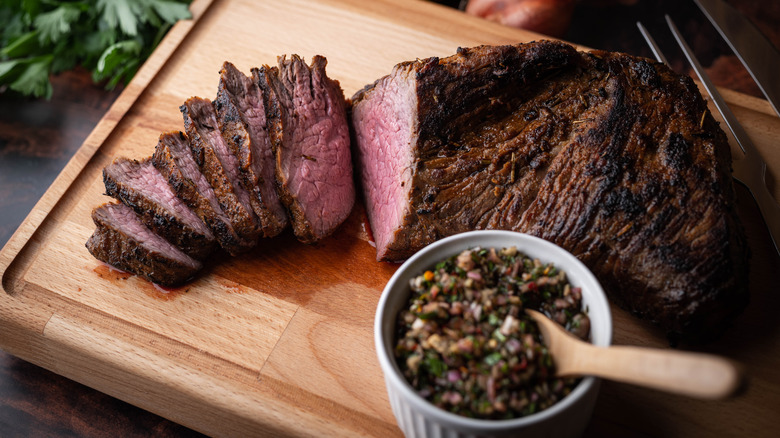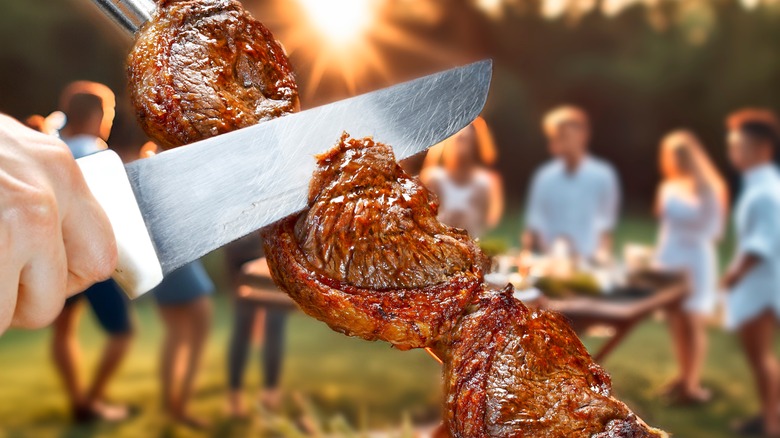The Best Steaks To Cook For A Special Occasion
Preparing a steak for a special occasion can be intimidating. Unless you're a butcher or a professional chef, you likely stick to the cuts you're familiar with and forget about the rest.
While keeping with the status quo is often the safe option, you could be missing out when it comes to dishing up luxurious steaks. Certain steak cuts may be less popular but no less delicious, with many rivaling even the most beloved cuts around. In this post, we'll unravel the web of confusion that often surrounds various steak options and lead you in the direction of selecting the beef that proves best for serving for a momentous event. Whether for a wedding reception, holiday, or even high school graduation, it can help to have a few steak recipes in your back pocket for serving eager guests.
For each cut of steak, we'll delve into its characteristics as well as explore common cooking techniques that can help bring these savory cuts to life. Moreover, we'll let you know if there's anything special to know about the steak and do our best to grace you with note-worthy ingredients and recipes to help boost your culinary confidence on the day of the big event. We'll explain a bit more on how we made our choices at the end, but for now join us as we slice into the absolute best steaks to cook for a special occasion.
Tomahawk ribeye
Ribeye steaks are ideal for special occasions for several reasons. This type of beef features beautiful marbling, is tender and juicy, and is considered a premium cut. A tomahawk ribeye is a variation of the typical ribeye, with its thickness and shape exuding both sophistication and flair. The fat and meat are trimmed away from its bone, leaving a handle behind similar to what you'd find on a rack of lamb. Its shape resembles a Native American Tomahawk ax, hence its name. What makes this a great option for a special occasion is its tenderness and flavor which is a result of its cut. When cooked, the flavors of the meat and bone harmonize to yield a delectable savor your guests will swoon for.
To cook, try grilled tomahawk ribeye steak with fine herbs and compound butter. This recipe isn't only easy to pull together, but the tenderness of the steak paired with the richness of the butter and herbs feels like fine dining. Pair your tomahawk steak with a light salad or creamed spinach to further upgrade the experience.
Lastly, remember that overcooking a ribeye steak rarely ruins it. Because of the amount of intramuscular fat in the meat, you'll rarely sample a tough and dry ribeye, making it even more of a plausible choice when you're looking to wow guests for a special occasion.
New York strip
You've likely seen the New York strip steaks featured on dine-in restaurant menus and may wonder if it's a feasible option for a luxurious meal at home. The answer? Absolutely. Like filet mignon, the New York strip is also a subprimal cut. It is usually a boneless steak, though a butcher may occasionally opt to leave the bone attached. Though this steak tends to exhibit bold and savory flavor, it is not known for tenderness. Don't let that frighten you, though -– its uniquely solid texture is what many love about this particular steak.
When selecting a New York strip steak, pay attention to the way it is cut. If the bone is left in, the meat closest to the bone will cook slower than the meat that's further away. Because of this, the bone-in New York strip may be tricky to cook evenly. If you'd rather skip the hassle, opt for a boneless New York strip. Butchers often recommend cooking the New York strip on a very hot grill for the best sear and flavor. If cooking indoors, a New York strip should (almost) always be cooked on a cast iron skillet for best results.
One last thing to note when selecting a New York strip for a special occasion is marbling. Make sure the meat you select has a good amount of fat laced throughout the meat. As it cooks, this fat will melt into the meat making for a tender, juicy, and flavorful meal.
Filet mignon
Filet mignon is often thought of as the crème de la crème of steak options. This tenderloin steak cut is one of the most tender and luxurious pieces of beef and is taken from the narrowest part of a tenderloin, the section from which the tenderloin tapers. Despite this fact, a filet mignon isn't narrow in shape but instead features a rounded appearance. This steak is usually 1.5-2 inches thick and typically weighs 8 ounces, though you can often find larger or smaller cuts.
While the filet mignon is often sold at a lofty price on swanky restaurant menus, it can be surprisingly affordable when purchased in stores making it an ideal selection for special occasions. There are a variety of opinions on which way is the right way to cook filet mignon, but pan-seared and roasted options tend to be the most effective given the thickness of the meat.
One option for cooking filet mignon is to simply sear it over the stovetop on both sides before transferring it to an oven preheated at 400 degrees Fahrenheit. Remove the steak from the oven once it reaches the desired internal temperature. Try dousing your filet mignon in regal flavorings, such as caramelized onion and bleu cheese, for an elevated take on this tender cut.
Porterhouse (or T-bone)
Impressing guests is easy when serving T-bone or porterhouse steaks for dinner. These two steaks are similar but different; there are size requirements that separate porterhouse and T-bone steaks. To be considered a porterhouse steak, the cut of beef must be at least 1.25 inches thick. If a steak is thinner than that, it will be designated a T-bone. The T-bone and porterhouse steak both contain a signature T-shaped bone in the middle, which features a tenderloin (or filet mignon) on one side and the strip loin (i.e., the meat of a New York strip) on the other. On the porterhouse steak, the tenderloin side will be larger, and the steak overall will be much larger in appearance than a traditional T-bone.
With that out of the way, consider grilling your T-bone or porterhouse steaks before smothering them in creamy mushroom sauce. The richness of the cream paired with the deep umami flavor of the mushrooms lends itself to splendid flavor, making for a magnificent dinner that is sure to make memories. Short on time? Even a bit of salt, pepper, and olive oil would do the trick. Pair with a lovely side dish and a glass of wine for a meal your guests won't forget.
Skirt steak
Skirt steak comes as both an inside and outside skirt cut. The inside skirt is typically the most flavorful though it is less uniform and more prone to shrinkage than the outside skirt. The outside skirt is thicker and is the more popular cut. Both come from the short plate primal section of cattle and are often used in stir-fries, fajitas, and more.
Because skirt steak is thin, it cooks quickly and proves a versatile choice for a variety of dishes. In fact, skirt steak can take as little as 3 minutes per side when grilled. Skirt steak also benefits greatly from the use of a marinade. Typical acids like red wine or vinegar in marinades can help tenderize the meat by breaking down some of the connective tissue. Feeling intimidated? Try skipping the marinade on skirt steak and create a flavorful sauce after cooking instead.
When preparing your skirt steak, take care to slice it against the grain. Neglecting this step will almost always result in tough and chewy meat.
Flat iron steak
Flat iron steak is a primal cut taken from the top blade. It is known for its exceptional tenderness, which makes it a splendid choice for special occasions and big events. It often comes beautifully marbled and packs plenty of juicy melt-in-your-mouth flavor. You can utilize flat iron steak in a variety of recipes, including those that traditionally call for skirt or flank steak. When looking for a flat iron steak in stores, note that you may see it sold as a "top blade" steak instead.
Seared flat iron steak is incredible when infused with tantalizing spices, herbs, and oil. You can also amp things up a notch by immersing the steak in a "post" marinade as detailed in this herby grilled flat iron steak recipe. No matter how you cook it, this cut of meat is one of the best inexpensive steak cuts to choose for a special occasion.
Hanger steak
Hanger steak isn't talked about as often as some of the other cuts on this list, though some chefs proclaim it to be one of the most underrated cuts of steak, given its flavor and tenderness. In fact, rumor has it that this cut was often kept by butchers for personal use, which is how it earned its nickname as the "butcher" steak. Hanger steak comes from the section of beef located under the rib primal, and when compared to skirt steak, it is a thicker cut.
It's best to remove the connective tissue membrane on the hanger steak before cooking – doing so can add to the tenderness of the steak. And though hanger steak is thicker than skirt steak, it is still thin enough to cook very quickly. If you want to delight the people you're cooking for during an event, try ladling the herb-caper sauce mentioned in this grilled hanger steak recipe over the meat for the ultimate flavor. Note that the steak will need to marinate for at least a couple of hours when using this recipe, but doing so will do wonders for developing flavors. Remember to allow at least 5 minutes of rest time before slicing into your hanger steak; permitting meat to sit for a while after cooking allows its juices to redistribute, resulting in a juicier taste.
Denver steak
If you've never heard of a Denver steak, listen up because it could be your next dinner party favorite. The Denver steak is described as a cross between a ribeye steak and a New York strip and comes from underneath the cattle blade. This cut is already tender, but because it is boneless, you can make it even more tender by pounding it.
The best way to cook the Denver cut of steak is to do so over indirect heat. To cook a Denver steak over a grill, you'll want to do so over a cool zone. This will allow the steak to cook through slowly. At the end of the cooking process, grill the steak quickly over high heat to ensure a good sear. Other methods of cooking a Denver steak with indirect heat, such as the sous vide method, are also viable. Either way, know that it doesn't take much in the way of ingredients to make this cut stand out. You can experiment with oil, salt, and pepper, or jazz things up a bit with balsamic vinegar, Worcestershire sauce, and garlic.
Tri-tip steak
Tri-tip steak is a popular steak cut in South America and is a phenomenal choice for special occasions if properly prepared. Tri-tip steaks are called such because of their triangular shape and are often sold cut into smaller 6-ounce pieces, as a roast, or whole. Though this cut is lean, it's known for its great flavor and marbling. In general, tri-tip steak is considered a tender cut of beef, making it just as good as any other well-known steak cut option.
When cooking tri-tip steak, grilling or broiling is usually the best course of action. Just be sure to avoid overcooking it; doing so can lead to toughness. Once cooked through, allow the steak to rest before slicing it against the grain for added tenderness. If you're feeling creative, try experimenting with new flavors with this grilled tri-tip with blackberry mustard recipe. The ingredients used are distinctly unique and are sure to entice your party guests. For a more straightforward approach, try a grilled and glazed tri-tip, which utilizes brown sugar, sweet vermouth, salt, and pepper to showcase the taste of the meat without going overboard.
Methodology
This assortment of the best steaks to cook for a special occasion was selected by first researching the most popular steak cuts sold in the United States. We did a deep dive on each cut, noting pertinent information about its texture, tenderness, and use in recipes. Other less popular steak cuts were also considered and were mentioned in the post if they were deemed high-quality and flavorful options through research.
Though a higher price point is often indicative of a better cut of meat, it isn't always the case. Thus, price point, though mentioned, did not play an exclusive factor in whether or not a steak cut was featured. Cuts that are naturally tender were given special mention, as were steak cuts that pack tons of flavor. Of course, whether or not a steak should be classified as fitting for a special occasion is highly subjective — it is our goal to provide you with enough information to decide which of these steak cuts might serve as a delicious option for your next formal get-together.
Lastly, remember that not all steaks are created equal. Where you purchase your steak matters, and quality can vary amongst retailers.
